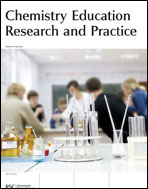Evaluating the effectiveness of organic chemistry textbooks in promoting representational fluency and understanding of 2D–3D diagrammatic relationships†
Abstract
The use of two-dimensional (2D) representations to communicate and reason about micromolecular phenomena is common practice in chemistry. While experts are adept at using such representations, research suggests that novices often exhibit great difficulty in understanding, manipulating, and translating between various representational forms. When used in conjunction with 2D illustrations, concrete and virtual models have been shown to increase novice understanding of 2D representations. However, such models are not always readily available. For this reason, it is vital that 2D textbook illustrations promote representational and diagrammatic competence. In this study, we use a self-designed rubric to evaluate the degree to which Newman (NPs) and Fischer Projections (FPs) are accurately introduced and described in seven frequently used Organic Chemistry textbooks. Additionally, we evaluate the success of these texts in including practice problems that encourage students to develop representational fluency by translating between different 2D diagrams. Results suggest that while most texts do a relatively thorough job of introducing the FP and NP, these introductions could be improved. Recommendations for how texts might increase novices' representational fluency through enhanced use of multi-representational examples, attention to molecule dynamics, and explicit characterization of the relationships between 3D molecules and their 2D projections are discussed.

 Please wait while we load your content...
Please wait while we load your content...